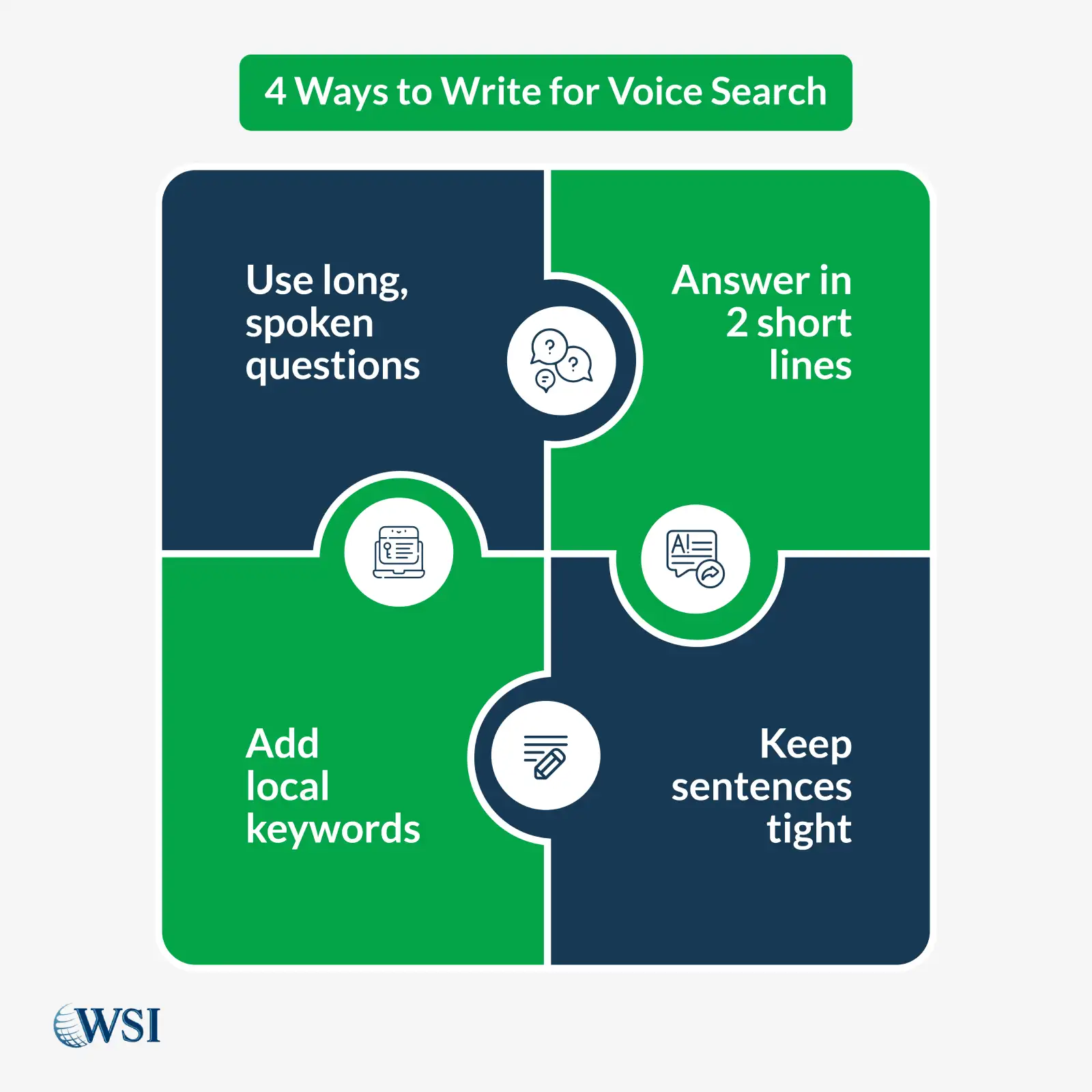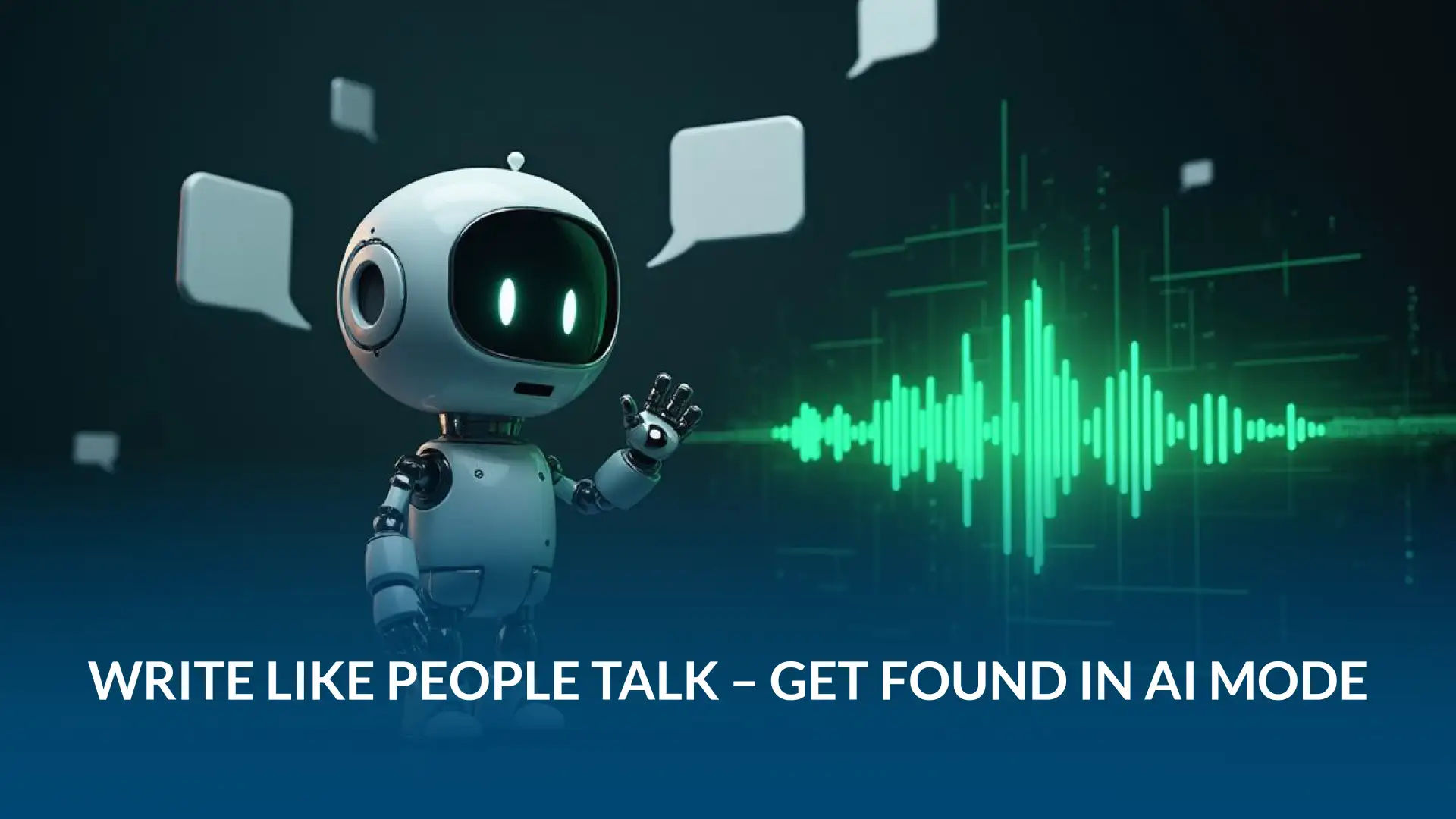B2B content is changing fast. Search behaviour has shifted from typing keywords to asking questions. Whether it’s Google’s AI Overviews or voice assistants like Siri and Alexa, people are looking for natural, straight-to-the-point answers. If your content doesn’t match how real people talk, it’s likely being skipped over.
This guide walks you through how to write for this new reality. From structure and tone to optimization tools and success signals, you’ll see how to future-proof your B2B content so it performs in AI Mode, voice search, and real-world conversations.
Key Takeaways:
- Writing conversational content means answering real questions the way people speak, especially for AI Mode, voice search, and mobile users.
- Structure your pages with clear, question-based H2s, short and direct answers, and long-tail spoken phrases to increase visibility in AI Overviews and featured snippets.
- Use tools like People Also Ask, AnswerThePublic, ChatGPT, and Clearscope to surface natural-language queries, maintain clarity, and ensure your content aligns with how modern users search.
Contents
Why Conversational Content Is Now Important
Search engines have shifted how they interpret intent. It’s no longer about exact keywords. It’s about how people ask real questions using natural language. Google’s AI Mode, voice assistants, and mobile search all prioritize this pattern.
When someone says, “What’s the best CRM for manufacturing?”, they want a direct answer, not a marketing brochure. The content that wins is content that responds like a real person would. That means clear, spoken phrases, scannable answers, and conversational flow.
Key insight: You’re not just writing for keywords anymore. You’re writing for questions, and the ones people say out loud.

Not Sure Where to Start with Conversational SEO?
Leap Digital helps B2B brands write like people talk and get seen. From keyword mapping to voice-friendly page templates, we build strategies that align with Google’s AI
Characteristics of Conversational Content
If your content sounds like a conversation, it’s more likely to appear in AI Overviews and voice search results. That means sounding helpful, smart, and real, not robotic or jargon-filled.

Question-First Format
Start with the kinds of questions your audience would actually ask. Make them your H2s.
- “How does fractional CFO support help SaaS companies?”
- “What’s included in a corporate training audit?”
- “Why do B2B companies need virtual CIOs?”
These are search-friendly and voice-ready. They also create immediate context for Google to understand.
Direct, Natural Answers
Once you ask the question, answer it fast. Think 1–2 plain-English sentences. Then, expand if you need to.
- “A fractional CFO provides financial strategy without the cost of a full-time executive. It’s ideal for SaaS startups scaling quickly.”
That’s the kind of snippet Google pulls into an AI result. Keep it short and helpful.
Tone That Reflects Dialogue
You’re not writing a whitepaper. You’re talking to a sharp colleague who wants answers.
- Use contractions like “you’ll,” “they’re,” and “it’s”
- Keep the rhythm natural, like you’re on a Zoom call
- Don’t over-polish; just get to the point
Simple, Accessible Language
The goal isn’t to sound academic. It’s to be understood.
- Use examples: “Think of a vCIO like a part-time CTO who helps steer your tech roadmap.”
- Break up long ideas with lists or analogies
- Be clear, not clever
Structuring B2B Pages for Conversational Intent
Every page you publish should follow a structure that mimics real-world dialogue. Don’t bury your best answers. Lead with them. Here’s how to lay out your content for AI Mode, voice search, and actual readers.
Blog Format: Answer the Big Question First
Your H1 should be the user’s main question. Start strong.
Example Structure:
- H1: What is a Virtual CIO?
- H2: Why Companies Hire a vCIO
- H2: What Services Do They Provide?
- H2: How to Choose a Virtual CIO
- H2: FAQs
This layout works because it tracks with how people search. Each header aligns with an actual query.
Service Page Format: Guide Like a Human
Service pages need to tell a story. They also need to rank. Keep it human while hitting the right structure.
Example Layout:
- Intro paragraph that sets the stage
- H2: How Our Service Works
- H2: Common Questions (built with FAQ schema)
- H2: Who It’s For
- H2: Why It Matters (add client stories or examples)
This setup helps both humans and algorithms get the full picture, fast.
Optimizing for Voice Search
Voice search is all about speed and context. If your answer isn’t clear in the first sentence, you’ve already lost the lead. Here’s how to tune your content to win in voice-driven environments.
Use Long-Tail, Spoken Phrases
People don’t search the way they write a document. They speak in full, casual questions. That’s what voice assistants are built to understand, and that’s what Google surfaces in AI Mode.
- “What are the best CRMs for Canadian B2B companies?” sounds like a real person talking.
- “Which CRM works well for a sales team with 10 people?” adds context and specificity.
- “Can I integrate a CRM with QuickBooks?” mirrors how a decision-maker thinks aloud.
These aren’t just good for SEO, they’re good for clarity. Use them in headers, opening lines, and even meta descriptions. They’re more likely to match user intent and earn a featured position in search results.
If you’re unsure what your audience is saying, listen to sales calls or use tools like AnswerThePublic. People are already giving you the phrasing, they just need to see it reflected on your site.
Optimize for Featured Snippets
Google pulls answers from pages that are easy to scan and quick to deliver value. The trick? Make your formatting impossible to miss.
- Answer the main question right after the H2, within the first 2 lines.
- Use a list or step format when explaining a process, checklist, or set of tools.
- Bold keywords or phrases so scanning readers, and search bots, don’t miss what matters.
If you’re outlining “how to choose a B2B CRM,” don’t just write a paragraph. Break it down:
- Identify team size and use case
- Check integration compatibility
- Review customer support ratings
- Compare pricing models
This layout is not just reader-friendly, it’s snippet-ready. It shows structure, clarity, and intent alignment.
Write with Local or Contextual Modifiers
People use voice search to solve problems in a particular place, role, or timeframe. So your content should reflect that specificity.
- “In Ontario” might show you’re relevant to local regulations.
- “For B2B startups” signals niche understanding.
- “Near Mississauga” helps local businesses find you.
- “In Q4 2025” shows your insight is timely.
These phrases help your content show up in the right moments. They also tell search engines, “This content understands context.”
Want more results? Localize your service pages. Add industry and region modifiers to blog titles. Reflect the actual conditions your audience is navigating.
Keep Sentences Short and Scannable
Both voice interfaces and mobile readers reward brevity. Your job is to say more with fewer words, and make it easy to follow on a small screen or smart speaker.
- Keep sentences between 12 and 15 words when possible.
- Use line breaks after every 2–3 sentences.
- Insert bullets or numbered lists for clarity.
Think of your content like a script. Could someone read it out loud without stumbling? Would a listener remember the key points?
Use whitespace like a design element. It gives your ideas room to breathe and signals where one thought ends and another begins.

Want Pages That Show Up in AI Overviews?
Our copywriters craft question-first content that ranks in Google’s featured snippets and voice results. Let us build SEO pages that sound human and convert traffic.
Tools to Use to Create Conversational Content
Conversational tone of voice is what keeps readers interested when it comes to reading your content. There are several tools that you can use to make this happen. People Also Ask, AnswerThePublic, ChatGPT, Yoast or Clearscope are few of the many tools that can help you structure your content in a way that you are speaking directly to your audience.
People Also Ask
This is a built-in Google feature that displays a series of related questions based on your original search. It expands with each click, revealing deeper queries users are actively exploring.
- Best used for sourcing real-world follow-up questions your audience is asking
- Ideal for shaping H2s and FAQ sections using natural language
AnswerThePublic
AnswerThePublic scrapes search engines to surface the most common questions, comparisons, and prepositions associated with a keyword. It visualizes these results in a wheel or list format grouped by intent type (what, where, how, etc.).
- Best used for brainstorming voice-search-style questions
- Great for long-tail keyword discovery and building out full topic clusters
ChatGPT
ChatGPT is an AI writing assistant that can simulate natural conversation. It’s useful for role-playing scenarios, generating buyer questions, and mapping out page outlines with a human voice.
- Best used for ideating user-centric questions and creating draft content
- Helps surface FAQs and headings from the perspective of your target audience
Yoast or Clearscope
Yoast is a WordPress plugin that provides real-time SEO and readability feedback. Clearscope analyzes top-ranking content and gives keyword suggestions and content grade benchmarks to help you match quality.
- Best used for improving clarity, structure, and on-page SEO
- Ensures your content stays at a B2B-appropriate reading level (Grade 7–9) and ranks competitively
Signs You’re Doing It Right
Not sure if your content is working for AI Mode and voice search? These indicators will confirm that you’re heading in the right direction. Instead of looking only at traditional SEO metrics, you want to track how well your content performs in conversational, AI-powered contexts. These signs will show that your strategy aligns with how people search and how platforms interpret relevance.
More Featured Snippets
- Google is pulling your answers into rich results, especially Q&A-style content
- You’re showing up above position #1 in a “zero-click” result
- Your headers match natural questions and your answers are structured clearly
- Content includes bullets, tables, or bolded phrases that Google prefers to excerpt
Increased Traffic from Long-Tail Queries
- Look for search phrases with 6+ words that reflect natural, spoken questions
- Review Google Search Console for queries like “how do I automate X” or “what’s the best tool for Y”
- Identify rising traffic from informational queries versus transactional or branded ones
- These long-tail terms often convert better because they indicate specific, high-intent problems
Higher Engagement from Mobile and Voice Users
- Lower bounce rates from mobile visitors because content is easier to scan and digest
- Longer dwell time on articles that lead with questions and offer bite-sized answers
- Improved scroll depth when pages use whitespace, short paragraphs, and spoken formatting
- Voice search users spend more time when answers feel direct and helpful, not promotional
AI Overviews Citing Your Content
- Your content appears directly within AI-generated summaries or overviews
- Google highlights your site under “as cited by” references in its generative answers
- Your page structure makes it easy for AI to extract self-contained answers
- This means you’ve nailed clarity, relevance, and formatting across devices and channels
Voice Isn’t the Future, It’s Now
Voice search and AI Mode aren’t coming soon. They’re already changing how content gets seen. If your content isn’t conversational, you’re not just behind, you’re invisible.
Writing like a person talking to another person isn’t lowering the bar. It’s raising your relevance. Real B2B buyers want real answers in a format that feels natural. They want to feel like you get them, because you wrote like you were listening.

Get Your Content Voice-Search Ready
Leap Digital’s optimization package ensures your blogs, landing pages, and service content are structured for mobile, voice, and AI-driven search.

